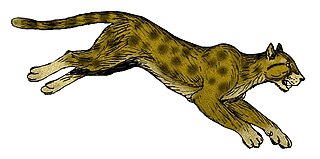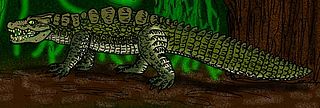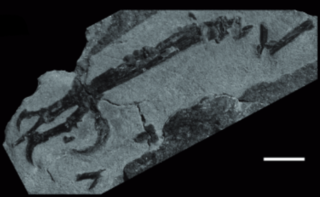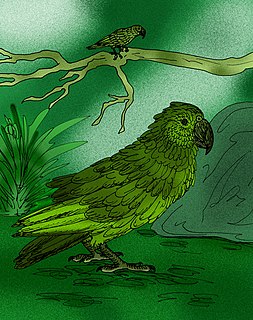
Plestiodon inexpectatus, the southeastern five-lined skink is a common skink in the southeastern United States.

Mekosuchinae is an extinct subfamily of crocodylids from Australia and the South Pacific. They first appear in the fossil record in the Eocene in Australia, and survived until the arrival of humans: in the Pleistocene in Australia and within the Holocene in the Pacific islands of Fiji, New Caledonia and Vanuatu. There is however disagreement on whether or not Mekosuchinae is a true subfamily within Crocodylidae, or a distinct crocodilian family in its own right, Mekosuchidae, within the superfamily Crocodyloidea.

The American cheetah is either of two feline species of the extinct genus Miracinonyx, endemic to North America during the Pleistocene epoch and morphologically similar to the modern cheetah. These cats were originally known from fragments of skeletons, but nearly complete skeletons have been recovered from Natural Trap Cave in northern Wyoming.

Mekosuchus is a genus of extinct Australasian crocodiles within the subfamily Mekosuchinae. They are believed to have been made extinct by the arrival of humans on the South Pacific islands where they lived. The species of this genus were small in size, 2 m in maximum length, and terrestrial, making them the last surviving group of fully terrestrial crocodilians, leaving only semi-terrestrial species such as the Cuban crocodile and the dwarves Osteolaemus and Paleosuchus.

Trilophosuchus is an extinct genus of mekosuchine crocodilian from Australia. Unlike living crocodilians, it is hypothesized to have been terrestrial. Trilophosuchus was approximately 1.5 metres (4.9 ft) in length. It had a short skull with three ridges on top and large eyes. Fossils have been found at Riversleigh in north-western Queensland, and are Miocene in age. Only a single species has been described, the type species T. rackhami.
Aellen's pipistrelle is a species of vesper bat. It can be found in possibly Benin, Cameroon, Ghana, Nigeria, and Sierra Leone. It is found in dry and moist savanna.
Phrynobatrachus inexpectatus is a species of frog in the family Phrynobatrachidae. It is endemic to southern Ethiopia. It is known with confidence from only three localities, but it may be more widely distributed in the Ethiopian Highlands. The specific name inexpectatus refers to the unexpected discovery of this species among museum specimens assigned to Phrynobatrachus minutus. Common names unexpected puddle frog and Largen's dwarf puddle frog have been coined for it.

The marbled frogmouth is a bird in the family Podargidae. The species was first described by Jean René Constant Quoy and Joseph Paul Gaimard in 1830. It is found in the Aru Islands, New Guinea and Queensland. Its natural habitats are subtropical or tropical moist lowland forest and subtropical or tropical moist montane forest.

The crested roundleaf bat is a species of bat in the family Hipposideridae. It is endemic to Indonesia.

Lazarussuchus is an extinct genus of amphibious reptile, known from the Cenozoic of Europe. It is the youngest known member of Choristodera, an extinct order of aquatic reptiles that first appeared in the Middle Jurassic. Fossils have been found in Late Paleocene, Late Oligocene, Early Miocene and Late Miocene deposits in France, Germany, and the Czech Republic. Two species have been named: the type species L. inexpectatus ("unexpected") from the late Oligocene of France and Germany and L. dvoraki from the early Miocene of the Czech Republic. It was not a large animal; the skull of L. inexpectatus was only about 4.53 centimeters long (1.78 in), with the total preserved body and tail length being just over 30 centimetres. A complete specimen of Lazarussuchus with preserved soft tissue was found from the Late Paleocene of France, but has not been assigned to a species.

Pachytriton, also known as the paddle-tail newts or Chinese newts, is a genus of salamanders in the family Salamandridae. They are found in southeastern China.
Schizodactylus inexspectatus is a species of dune cricket (Schizodactylidae) endemic to sand dunes near Gülek, Turkey.
Scarabaspis is a genus of mites in the family Eviphididae. There is at least one described species in Scarabaspis, S. inexpectatus.

Intiornis is an extinct genus of avisaurid enantiornithean birds which existed in what is now North-West Argentina during the late Cretaceous period.

Shuvosauridae is an extinct family of theropod-like pseudosuchian within the clade Poposauroidea. Shuvosaurids existed in North America and South America (Argentina) during the Late Triassic period. Shuvosauridae was named by Sankar Chatterjee in 1993 to include the genus Shuvosaurus.
Monochamus inexpectatus is a species of beetle in the family Cerambycidae. It was described by Stephan von Breuning in 1935.
Dierogekko inexpectatus also known as Key New Caledonian Gecko is a gecko endemic to Grande Terre in New Caledonia.
Trephionus inexpectatus, is a species of beetle belonging to the family Carabidae. It is endemic to Japan.
The Dar-es-Salaam dwarf gecko is a species of gecko endemic to Tanzania.

Heracles inexpectatus is a giant fossil parrot species from New Zealand, assigned to a monotypic genus Heracles, that lived during the early Miocene approximately 16 to 19 million years ago. The species was described from fossils discovered in 2008 at Saint Bathans, Otago, New Zealand. It is believed that the species stood up to 1 m tall and weighed approximately 7 kg (15 lb). Initial analysis suggests it is from the superfamily Strigopoidea, which consists of three confirmed genera of parrots: Nestor, Strigops (kakapo) and the fossil Nelepsittacus. It may have been the ancestor of the Kakapo.











